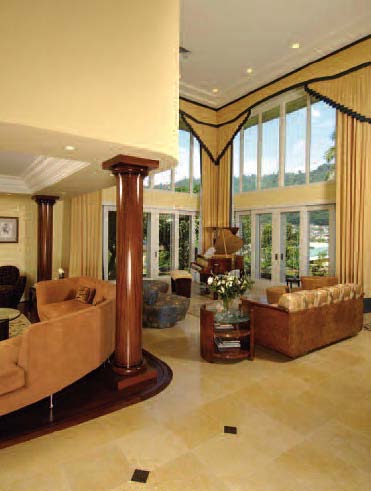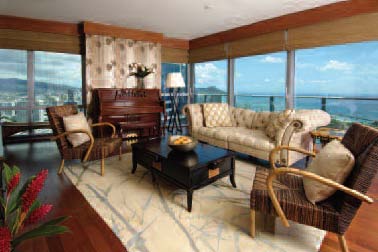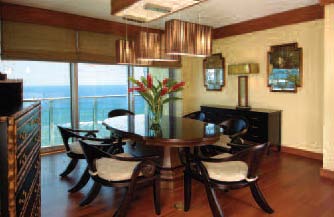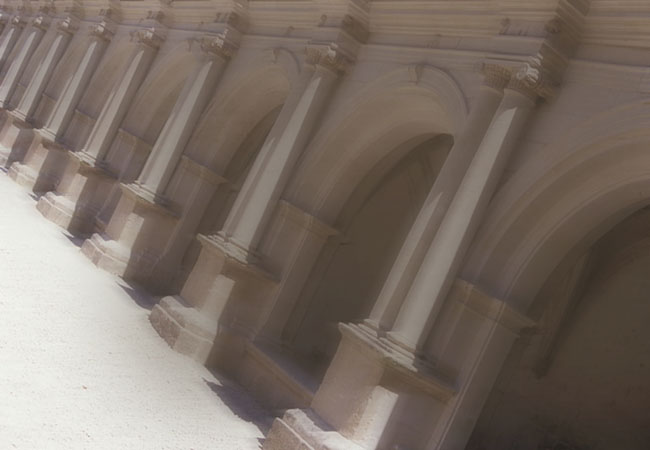|
 Articles Articles
|
Richard Peterson, AIA
Versatile Interior Designer Creates Each Living Space
As “Custom Artwork” That Soothes, Inspires, And Heals
|
By Marcus Webb
Photography by David Frazen
|
| CAN ARCHITECTURAL AND INTERIOR design truly serve as healing arts? They can when Richard Peterson is the artist. One measure of just how well he succeeds in achieving this ambitious goal is the glowing thank-you letter he received from the owners of the Manoa Valley Retreat, a brand-new mountain home with ocean views above Honolulu, for which Peterson served as both architect and interior designer.
The husband explained that his wife’s challenging physical condition clearly and dramatically benefited from the uplift and inspiration of their beautiful new home. “You listened to us and shaped our dreams into reality…that by far exceeded our expectations,” he wrote.
|
| “The results are morethan I believed possible.” The Manoa Valley Retreat won a 2006 distinguished entrant award for architecture and design in the 2006 BIA Hawaii Renaissance Building and Remodeling Awards, and in the 2006 AIA Honolulu Design Awards. How does Peterson explain the impact of home design on body and soul? “If you live in a concrete jungle, you suffer. If you live in green nature, it speaks to your spirit,” he declares. “I have a deep belief that we live in theenvironments that we build, and they live in us. The cities, our towns, our neighborhoods, our houses, and ourinteriors have a profound effect on ourwell-being, our identity, our social interaction, and even our physical health.
|
|
|
|
 The more beauty, peace, and harmony Ican design into a space or building, especially if it faithfully reflects the homeowner’s lifestyle, the more powerful and beneficial will be the interaction between the person and the space.” The more beauty, peace, and harmony Ican design into a space or building, especially if it faithfully reflects the homeowner’s lifestyle, the more powerful and beneficial will be the interaction between the person and the space.”
This bold statement is only the beginning of Peterson’s artistic credo.
Although most of the time he as relaxed and informal as any Hawaiian can possibly be (and he laughs easily), once the Honolulu-based designer gets warmed up on his favorite topic, a passionate artist emerges. Motivated by a fierce love of beauty and deep respect for Hawaiian culture, his words rush out in a tumble.
“I’m an artist first and foremost.” Peterson says happily. “I like to design for clients by working closely with them to ensure their homes are beautiful and healing and in context with each structure’s particular environment. Every project I do is unique; I simply can’t imagine using variations on the same design formula every time. My favorite approach is getting to know my clients very well and designing specifically for their personalities and how they live. I look at interiors as a three-dimensional artwork, like sculpture.
First you shape the space and volume; then you create living areas within that space to ensure that environment, form, materials and colors work together in a beautiful yet functional manner that is unique to each home, since all people live differently.”
Realizing that he may have gotten a bit carried away, Peterson pauses for a moment. More quietly, he adds: “When homeowners see what design can do— how their home can be a living, breathing extension of themselves, and how it can create a nurturing connection between their environment and their physical and spiritual well-being, their jaws drop— and I’m delighted.”
A laid-back former Californian by birth, Peterson is the grandson of a Beverly Hills real estate developer. He came to Hawai‘i to surf in 1968, but stayed to create art in the form of interior design and architecture. These days, he regularly wins nominations and awards for residential and commercial work in Hawai‘i, on the Mainland, and in China and Japan.
Richard Peterson Design, consisting of the principal and his two-person staff, is now in its third successful decade of tackling projects large and small. Their portfolio ranges from retro-style beach cottage renovations to glitzy condominiums; imposing hotel lobbies; multi-unit complexes; elegant mountain estates; boutiques and super stores; contemporary and traditional single family residences; and more.
It’s no surprise that Peterson takes a passionate artistic approach to his work, since he earned degrees in architecture and fine art at the University of Hawaii. But Peterson also insists on delivering businesslike discipline and efficiency. There’s no “artistic temperament” involved here—and no impractical dreaming, either.
“I worked my way through college in construction, which gave me a solid foundation throughout my career,” he says. “I don’t just know theory; I know how buildings are put together. When a designer understands structure and materials, he can design more economically, saving significantly on materials and labor. We are committed to creating the most practical and aesthetic solutions for each client’s unique requirements and environment,” he continues. “It is our commitment to listen to our clients; to manage each assignment with the best systems appropriate; and to deliver projects with excellence in design, concern for the environment, knowledge of practical technology, and an understanding of cost and sensitivity to schedules.”
|
|
 One of Peterson’s most treasured assignments this year was renovating and restoring a 1938 beach cottage in Kahala. The historic home was originally created by one of Hawai‘i’s great 20th century architectural icons, Vladimir Ossipoff, but had undergone more than one remodel over the decades. Peterson took great pleasure updating the structure while returning as far as possible to Ossipoff’s original vision. One of Peterson’s most treasured assignments this year was renovating and restoring a 1938 beach cottage in Kahala. The historic home was originally created by one of Hawai‘i’s great 20th century architectural icons, Vladimir Ossipoff, but had undergone more than one remodel over the decades. Peterson took great pleasure updating the structure while returning as far as possible to Ossipoff’s original vision.
Peterson and his team are also masters of contemporary Hawaiian styles. A good example is their recent $400,000 remodeling project for a 2,500 square foot, $3 million oceanfront Honolulu penthouse at Hokua Condominiums.
This 39th floor corner unit features expansive views of the ocean and Diamond Head. Peterson and his team replaced the stark white carpet, doors, and fixtures with warm wood flooring and paneling, to create a naturalistic setting for an eclectic mix of traditional, Asian,and tropical furnishings, motifs, and fixtures. The result is rich, worldly, yet understated, elegance.
 “Today Hawai‘i is undergoing a design renaissance,” Peterson observes. “In every home and building that we design, we seek to generate a contemporary yet authentically Hawaiian feeling that is less about glitz, and more about ‘a sense of place’—to use Mary Philpotts McGrath’s famous phrase. People move to Hawai‘i to simplify their lives. Everything we create in the Islands needs to be in the context of living in the Islands with an indoor-outdoor tropical lifestyle. My interpretation of this value is that our mission is to design in context. Even with a remodeling project of a contemporary structure that may not have much Island feeling, our approach is to take whatever Hawaiian elements are there and expand on them. We like to contrast earthy Hawaiian textures with simple, Zen-like lines and form, together with a little bit of Hawaiiana.” “Today Hawai‘i is undergoing a design renaissance,” Peterson observes. “In every home and building that we design, we seek to generate a contemporary yet authentically Hawaiian feeling that is less about glitz, and more about ‘a sense of place’—to use Mary Philpotts McGrath’s famous phrase. People move to Hawai‘i to simplify their lives. Everything we create in the Islands needs to be in the context of living in the Islands with an indoor-outdoor tropical lifestyle. My interpretation of this value is that our mission is to design in context. Even with a remodeling project of a contemporary structure that may not have much Island feeling, our approach is to take whatever Hawaiian elements are there and expand on them. We like to contrast earthy Hawaiian textures with simple, Zen-like lines and form, together with a little bit of Hawaiiana.”
Given his profound belief in the connection of nature and soul, it’s no accident that Hawai‘i is not only the locale of Peterson’s life and work, but also his driving inspiration. Yet this extraordinary sensitivity to the gorgeous tropical surroundings of the Islands makes Peterson the designer and architect that he is.
“The environment we live in totally influences our health, how we live, and who we are,” he says. “To be surrounded by beauty in art and design, by the calmness of a natural color palette with greens and golds, all blends to create the serenity and comfort that you should enjoy in your home, no matter how simple or how grand the structure may be.”
|
|
|
